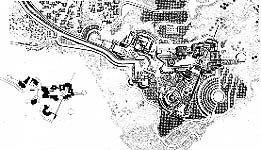"Los
Ángeles, ciudad de eterna primavera, tiene cuatro estaciones: temblor de tierra,
incendio, inundación y sequía"
Dicho popular
Para algunos el Centro Getty, recostado sobre las colinas de Santa Mónica
y con la autopista a San Diego serpenteando a sus pies, se asemeja a un monasterio o a una
fortaleza. Puede ser. La imagen más usual que guardamos de un monasterio suele asociarse
con la de una estructura defensiva. No en vano, los monasterios, en su apogeo, fueron
búnkeres que custodiaron la sabiduría: la ciencia y el arte. El complejo museístico del
Getty Center no es más que eso: unas cuantas cajas fuertes que atesoran estos
bienes un milenio después. Un centro de exposición e investigación sobre el arte. A
este, como a aquellos recintos medievales, se accede por un angosto y empinado sendero que
parte desde la freeway I-405.
Sin embargo, se parece más a una "acrópolis" griega, con los
edificios dispuestos, aparentemente, al libre albedrío, contrastando con la naturaleza
del paisaje al oponer sus rectas y nítidas aristas, casi todas de raíz cúbica. Así
actuaron los arquitectos de tantos templos griegos, quienes, además, rodearon los
recintos sagrados con un perímetro de murallas que arrancaba de la roca desnuda. De modo
similar, el Centro Getty, constituido por una serie de pabellones diferenciados y un
jardín, se alza sobre taludes de travertino desbastado en medio del disperso bosque. Para
mejor metáfora piénsese en el color y la textura elegida por Richard Meier para el
acabado final. Piedra casi amarmolada en basamentos y volúmenes prismáticos, granito en
los suelos y sus características placas cuadradas blancas y beig, sin brillo, para las
envolventes. Se ha optado a propósito "por un sólido clasicismo" como imagen
simbólica para que las moradas de los dioses del siglo XX se posen sobre la tierra.
Aunque lo tradicional en el currículum de este master builder es su europea
modernidad, centrada en la revitalización de sus inicios heroicos.
Mientras los griegos adoraban a sus ídolos en los templos dispersos en el
interior de aquellos lugares de peregrinación, los ciudadanos americanos pueden admirar
la colección de arte europeo que se muestra en las distintas salas de esta "ciudad
ideal para la cultura". Probablemente, el gran Museo que ha construido el Getty
Trust, avistando la bahía desde Malibú hasta Venice, sea un santuario de nuestra
época en el que el arte ha sustituido a los dioses del Olimpo. Y no es esta una
afirmación gratuita. De hecho, según Mario Botta, autor del MoMA de San Francisco,
cualquier museo se podría interpretar "como un espacio dedicado a la búsqueda de
una nueva religiosidad". En su opinión "en la ciudad actual, el museo
desempeña un papel similar al de la catedral en siglos pasados". Y la catedral de
Los Ángeles no puede ser un hito aislado como el MoCA de Arata Isozaki u otros museos
confundidos en la inmensidad urbana. La catedral de la ciudad más extensa del planeta ha
de tener otra escala, la cual se corresponde con la de una acrópolis.
Partiendo de estas condiciones (representatividad, emplazamiento y
programa), el Centro Getty dispone sus edificaciones de un modo salpicado sobre dos mallas
ortogonales, giradas entre sí, que resultan un reflejo de las dos direcciones que toma la
autopista al curvarse bajo el enclave: la trama de Los Ángeles una, el paso de Sepúlveda
la otra. Esta sutil referencia sirve de excusa a la geometría ordenadora del complejo
cultural, en donde se despliega una colección de arquitecturas como si se tratara de un collage
en tres dimensiones. La propuesta resultante, tan ensimismada en su apariencia azarosa,
puede hacer pensar que Richard Meier se ha guiado por la metrópolis ya que, como afirma
Ann Bergren, "si la discontinuidad es la realidad urbana de Los Ángeles, lo realista
es diseñar edificios en forma de piezas". Pero nada más lejos, porque el centro
cultural no obedece a ley alguna de secuencias cinematográficas, aunque al visitarlo se
sucedan excelentes travellings.
Esta "ciudad ideal" está constituida por seis edificios
asentados sobre un conjunto de plataformas a distintos niveles que se adaptan a los
pliegues del terreno. A sus espacios abiertos se accede mediante un par de trenes que unen
la explanada central, antesala del Museo, con la terminal junto a la freeway. La
gran terraza que da la bienvenida, en la cima, animada por fuentes, arbolado y pérgolas,
está flanqueada por tres pabellones: el auditorio, el centro de información y el
restaurante. Este mismo ritual se repetía al pasar por los propileos, junto a ellos un
conjunto de pórticos daban sombra y resguardo al peregrino que ascendía y llegaba
cansado. |
"Los
Angeles, a city of endless spring, it has got four seasons: earthquake, fire, flood and
drought".
A popular sayingFor some people the Getty Centre, leant on the hills of Santa
Mónica and with the motorway to San Diego winding at their feet, resembles a monastery or
a fortress. It is possible. The most common image of a monastery usually reminds us of a
defensive framework. The monasteries were, in fact, bunkers at their height when they
guarded the wisdom: science and art. The museum complex Centro Getty is no more
than that: a few safes accumulating these properties a millenium later. A centre of art
exhibition and research. Like in those medieval enclosures, you arrive at this centre
through an steep and narrow path which begins in the autopista I-405.
However, it looks more like a greek acropolis with its buildings arranged apparently at
free will, contrasting with the nature of the landscape on opposing its straight and sharp
edges, most of them in cube root. The architects of so many greek temples worked this way,
enclosing, in addition, the sacred area with a perimeter of walls which stemmed from the
bare rock. In a similar way, the Getty Centre, made up of a series of different pavilions
and a garden, stands out over slopes of scabbled travertine in the middle of the scattered
wood. As for a better metaphor, let’s consider the colour and texture chosen by
Richard Meier for the finishing touch: almost marmoreal stone in plinths and prismatic
sizes, granite on the floors and his characteristic brightless white and beige square
plates for the enveloping surfaces. It has intentionally been opted "for a sound
classicism" as a symbolic image so that the dwellings of the twentieth century gods
can settle on the earth. Though the traditional part in the curriculum of this maestro
de obras is his european modernity, focused on the renaissance of his heroic
beginnings.
Whereas the greeks worship their idols in the dispersed temples inside those places of
pilgrimage, the american citizens can admire the european art collection shown in the
different rooms of this "ideal city for the culture". The great Museum that the Grupo
Getty has built, sighting the bay from Malibú to Venice, could be probably a
sanctuary of our times in which art has replaced the Gods in the Olympus. And this is not
a gratuitous remark. In fact, according to Mario Botta, architect of the MoMA in San
Francisco, any museum can be understood "as an space devoted to the search of a new
religiousness". In his opinion, "the museum fulfils in the modern cities a
similar part to that of the cathedral in the past centuries". And the cathedral of
Los Angeles cannot be an isolated milestone like the MoCA of Arata Isozaki or other
museums that are confused in the urban vastness. The cathedral of the most extensive city
in the planet must have another scale, which corresponds to one of an acropolis.
Starting from these conditions (representativeness, location and programme), the Getty
Centre arranges its buildings dotted about on two orthogonal networks, turned each other,
and happens to be a reflection of the two directions the highway takes when it bends under
the enclave: one is the area of Los Angeles, the other is the passage of Sepúlveda. This
subtle reference helps as an excuse the ordered geometry of the cultural complex, where a
collection of architectures is displayed as if it were a three dimensional collage. The
resultant proposal, so absorbed in its casual appearance, may lead someone to think that
Richard Meier has been driven by the Metropolis since, "if the discontinuity is the
urban reality of Los Angeles, the real thing its to design piece-shaped buildings",
Ann Bergren states. But it is far from it, because the cultural centre does not obey any
film sequence at all, although when visiting it, one can enjoy excellent perspectivas.
This "ideal city" is formed by six buildings, settled on a collection of
shelves in different levels and adapting themselves to the folds of the land. You arrive
at these open areas by a pair of trains which link the central esplanade, the anteroom of
the Museum, with the terminal next to the autopista. The lively big terrace at the
top welcoming the visitor, with fountains, trees and rooftop gardens, is flanked by three
pavilions: the auditorium, the information centre and the restaurant. The same ritual is
repeated on walking past the propylaeum, where a group of portals gives shade and
protection to the tired pilgrim who has just climbed. |
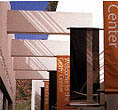
Pasaje de acceso a la terminal del tren junto a la autopista /
Entrance passage to rail station beside freeway

Acceso al centro getty: el auditorio./ Entrance to getty
centre: auditorium

Terminal del tren en la explanada central. / Rail station on
central esplanade
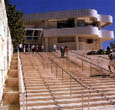
Escalinata de acceso al museo / Museum entrance steps

Marquesina de acceso al museo / Museum entrance canopy
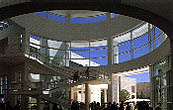
Rotonda del vestíbulo / Lobby rotunda

Plaza interior del museo: pabellón colecciones permanentes /
Museum courtyard: permanent collections pavilion

Plaza interior del museo: pabellón exposiciones temporales /
Museum courtyard: temporary exhibitions pavilion
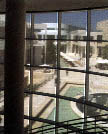
Plaza interior del museo vista desde el vestíbulo de un
pabellón / Museum courtyard seen from a pavilion lobby
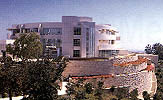
Centro de documentación y biblioteca: vista desde el acceso./
Document centre and library: view from entrance
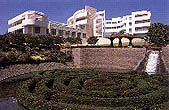
Centro de documentación y biblioteca: vista desde el jardín
de robert irwin / Document centre and library: view from robert irwin garden
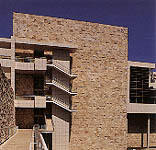
Testero sur del museo / South end of museum
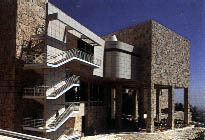
Terrazas panorámicas de la cafetería del museo / Panoramic
terraces of museum cafeteria
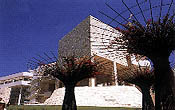
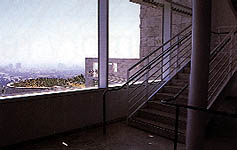
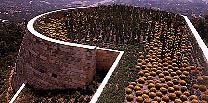
Talud con jardín del desierto de california visto desde el
interior del museo y desde la rampa con la autopista al fondo / Slope with california
desert garden, seen from museum interior and from ramp with freeway in background |
Hacia
arriba, ascendiendo por la escalinata, se anuncia la entrada al gran vestíbulo del Museo;
en un lateral quedan los edificios administrativos. Tras la marquesina que señala la
puerta, se despliega la potente rotonda acristalada, uniformemente iluminada, con el patio
interior como telón de fondo curvado. Aquí confluyen los ejes de toda la ordenación
urbanística, desde aquí parten los recorridos de visita y desde aquí se despliegan las
cinco cajas que contienen las salas de las colecciones permanentes y el pabellón de las
exposiciones temporales, volúmenes que giran y bailan alrededor de los estanques de una
plaza abierta a los horizontes. De alguna manera, el Museo es al Getty Center lo
que el templo principal de la deidad a la acrópolis: la casa donde residía el dios
protector de la ciudad.
Por último, hacia el océano queda el centro de documentación con la
biblioteca. Se trata de un cilindro vaciado por otro concéntrico y abierto en un
cuadrante. Su forma circular lo dota de autonomía frente al resto del complejo y refleja
el carácter introspectivo de su finalidad: la investigación histórica. Existe cierta
afinidad entre este volumen incompleto y las antiguas tolos, aquellos templos
redondos bajo la advocación de la ciencia aún desconocida. Esta última pieza se separa
y se une a los cubos del Museo y a los porches panorámicos de la cafetería a través de
un jardín en cávea, teatral, lleno de colorido (obra de Robert Irwin), con arbustos y
setos en laberinto, un estanque, la cascada y el riachuelo que surca el bosque (con su
zig-zag) y nace en el surtidor de la cima, próximo a la gran rotonda. Otros jardines del
Centro Getty, más del sur de California, rematan los taludes en círculo de los extremos
norte y sur.
Tras esta descripción, podría intuirse que la visita al Getty Center
puede llevar a confusión, tanto al entendido como el profano, y no es así en ninguno de
los pabellones, ni siquiera en el conglomerado del Museo. Aquí, como en las demás
partes, resulta muy fácil descubrir las perspectivas y la gradación de las secuencias:
basta con dejarse llevar por las circulaciones para disfrutar del espacio interior que se
prolonga en la mirada hacia el paisaje exterior: del propio conjunto y del territorio
circundante. Después de todo la poética de Richard Meier se repite, se refina y se
multiplica: retículas giradas, ordenación en collage, perspectivas estudiadas,
formas abiertas, volúmenes simples, proporciones áureas y composiciones abstractas en
base a una exquisita geometría que se autoalimenta. Y todo ello zurcido por un claro
sistema de recorridos que invita a pasear, descansar y contemplar unos espacios bañados
por una intensa luz blanca perfectamente controlada. Arquitectura exhibicionista que
muestra con delicadeza y privacidad los objetos de la colección. En cualquier caso, como
diría la crítica: "de Meier siempre esperamos un Meier".
Aunque el paralelismo histórico sea fortuito, no se debe olvidar que Roma
sentía una profunda admiración por la cultura griega, por ello adoptó a sus dioses,
para no sentirse huérfana y carente de pasado. Pero los romanos lo tenían todo y mejor:
ciudades ordenadas, grandes infraestructuras y legiones que garantizaban su supremacía.
Richard Meier no es un romano, aunque mentalmente se remonte al tiempo de estos evocando
Villa Adriana con "sus secuencias espaciales, imagen de solidez y sentido del
orden" para asegurarse que construcción y paisaje se pertenecen mutuamente. No lo
es, pero repite sus actitudes y comportamientos de modo blanco y sintético. Quizás el Getty
Center no sea una obra maestra, tal y como vemos la casa Smith, el Atheneum o el Museo
de Atlanta; pero es la obra de un Maestro: sabia y reposada. Todo un clásico.
Ahora bien, habría cabido esperar que este lugar sagrado presentase una
imagen más acorde con la actividad de la ciudad, después de todo, Los Ángeles es La
Meca del cine, el arte de este siglo. Desde sus estudios se han fabricado numerosos mitos
o héroes, aunque no dioses. ¿No habría sido más coherente construir un templo para las
estrellas del firmamento cinematográfico? Erigir en esta ciudad, donde la realidad supera
a la ficción del celuloide, un complejo museístico que idolatra el pasado europeo
equivale, en cierto sentido, a construir un mausoleo además de suponer una afrenta a la
más genuina contribución de la sociedad americana a la Cultura. En este caso, los
dioses, ofendidos, pueden provocar un cataclismo, entre otras cosas. |
As the visitor
goes up the outside staircase, the entrance to the large hall of the Museum is announced;
the administrative buildings lie at one side. The big glass circular gallery, plainly lit
up, is displayed behind the canopy that shows the door, with the inner yard as a bent
backdrop. The centre lines of all the urban planning meet here; the visit routes start
here and the fine boxes containing the permanent collection rooms and the temporary
exhibition pavilion are shown here,volumes that swing and dance round the lakes of an open
square on the horizon. To a certain extent, the Museum represents for the Centro Getty
what it did the main temple of the deity for the acropolis: the house of the protective
god in the city. Finally, the centre of documentation with the library remains towards
the ocean. It is a cylinder emptied by a concentric one and opened in a quadrant. Its
circular shape gives it autonomy as opposed to the rest of the complex and reveals the
introspective character of its purpose: the historic research. There is a certain likeness
between this incomplete volume and the ancient tolos, those round temples dedicated
to the yet unknown science. This last piece is separated and joined to the cubes of the
museum and to the panoramic arcades of the coffee shop through a colourful amphitheatrical
garden (designed by Robert Irwin) with a maze of bushes and hedges, a pond, the waterfall
and stream which spring up in the fountain at the top, cleaving the wood in zigzag, next
to the big circular gallery. Some other gardens in the Getty Centre, south- californian
style, finish off the circular slopes of the north and south ends.
After this description, one might feel that the visit to the Centro Getty can
lead both the expert and the layman to confusion, but it never does in any of the
pavilions, not even in the conglomerate of the Museum. Here, like in the other parts, it
is very easy to find out the perspectives and the gradation of the sequences: it suffices
to be carried away with the circulations for the visitor to enjoy the inner space,
stretching out before him towards the outer landscape: of the own collection and the
surrounding territory. After all, the poetics of Richard Meier recurs, becomes refined and
multiplied: turned networks, a collage arrangement, studied perspectives, open shapes,
simple volumes, golden proportions and abstract compositions on the grounds of an
exquisite geometry which feeds back. And everything is put together by a clear system of
routes that invites the visitor to walk, rest and contemplate the spaces bathed by a
perfectly controlled strong white light. Exhibitionist architecture delicately and
intimately showing the objects of the collection. In any case, "we always expect a
Meier by Meier", as the critic would say.
Although the historic parallelism can be chance, it must not be forgotten that Rome
felt a deep admiration for the greek culture, that is why they adopted their gods, in
order not to feel themselves orphans and without a Past. But the romans had everything
better: planned cities, large infrastructures and legions who guaranteed their supremacy.
Richard Meier is not roman, although he mentally goes back to their times recalling Villa
Adriana with "its space sequences, a solid image and sense of order" to make
sure that the building and the landscape belong to each other. It is not that way, but he
repeats their attitudes and behaviour in a synthetic and white manner. Perhaps the Centro
Getty is not a master piece, as we see the Smith house, the Atheneum or the Museum of
Atlanta, but it is the work of a Maestro: wise and relaxed. A true Classic.
Nevertheless, one would have expected that this sacred place should show an image
according to the activity of the city. Los Angeles is the "Mecca" of the cinema,
the art of this century. Many heroes and myths have been made in these studios, although
they are not gods. Would not have it been more coherent to build a temple for the stars of
the film firmament?. To build in this city, where the reality goes beyond the fiction of
the films, a museum complex which worships the european past is equivalent to build a
mausoleum and, at the same time, it is an insult to the most genuine contribution of the
American society to Culture. In this case, the gods, offended, can bring about a
cataclysm, among other things. |


